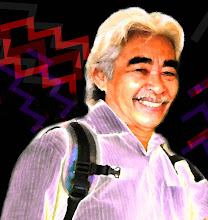 This morning we took to the road to a small town at the Malaysian-Indonesian border crossing.
This morning we took to the road to a small town at the Malaysian-Indonesian border crossing.The hour long journey through low-lying Kuching terrain gradually turned into sharp turns and steep climbs as we neared the second leg of the journey. The border town ,Tebedu sits on Malaysian soil and I noticed two physical projects that were underway that could give this town an economic boost, mainly a Custom, Immigration and Quarantine Complex and an Inland Port. However just by the look of it, I think the facilities will only be up and away probably another 3-4 years down the road.
 What captivated me throughout the journey was the 'ruralness' of the economic landscape. The paddy or rice fields were starting to be harvested on plots largely owned by subsistence farmers.
What captivated me throughout the journey was the 'ruralness' of the economic landscape. The paddy or rice fields were starting to be harvested on plots largely owned by subsistence farmers.I stopped to take a picture of two women busily harvesting the ripe paddy stalks. In Sarawak paddy is hardly grown on a commercial scale and very little mechanisation is used in its operation from tilling to harvesting. As such though Sarawak is under-populated and with a vast land size, it has for decades been importing rice from other neighbouring countries of South East Asia, principally Vietnam and Thailand which have proven to be much more advanced in technology and producing competitively new improved clones especially of fragrant qualities.
 Another unresolved issue in the productivity of paddy or rice in Sarawak is the problem of land tenure. Most of the land farmed by the farmers are owned by the state which does not award private ownership even though the families has been working on the land since their great great grandfathers. This issue of very fragmented and untitled land tenure constitutes a tricky political issue and many natives are upset over this unresolved problem lately. In many instances the government will grab the land from the farmers at will or with the tiniest of compensation ( akin to a pepper corn) which ultimately make the natives landless or homeless.
Another unresolved issue in the productivity of paddy or rice in Sarawak is the problem of land tenure. Most of the land farmed by the farmers are owned by the state which does not award private ownership even though the families has been working on the land since their great great grandfathers. This issue of very fragmented and untitled land tenure constitutes a tricky political issue and many natives are upset over this unresolved problem lately. In many instances the government will grab the land from the farmers at will or with the tiniest of compensation ( akin to a pepper corn) which ultimately make the natives landless or homeless.
 Another unresolved issue in the productivity of paddy or rice in Sarawak is the problem of land tenure. Most of the land farmed by the farmers are owned by the state which does not award private ownership even though the families has been working on the land since their great great grandfathers. This issue of very fragmented and untitled land tenure constitutes a tricky political issue and many natives are upset over this unresolved problem lately. In many instances the government will grab the land from the farmers at will or with the tiniest of compensation ( akin to a pepper corn) which ultimately make the natives landless or homeless.
Another unresolved issue in the productivity of paddy or rice in Sarawak is the problem of land tenure. Most of the land farmed by the farmers are owned by the state which does not award private ownership even though the families has been working on the land since their great great grandfathers. This issue of very fragmented and untitled land tenure constitutes a tricky political issue and many natives are upset over this unresolved problem lately. In many instances the government will grab the land from the farmers at will or with the tiniest of compensation ( akin to a pepper corn) which ultimately make the natives landless or homeless.Consequently the younger generation migrate to urban areas and being unemployed create much urban social problems , unrest and urban squalor.
 Another interesting thing I discovered today is the use of live plant for post to hold the pepper vines. Sarawak is among the top producers of pepper in the world. Sarawak pepper is now processed into a variety of products like sweets, perfume and of course the pepper flavouring chefs all over the world sprinkle steaks with, viz black, green or white varieties. Pepper growing demands intensive care and thus is carried out largely as a family concern like the small pepper plot in the above picture.
Another interesting thing I discovered today is the use of live plant for post to hold the pepper vines. Sarawak is among the top producers of pepper in the world. Sarawak pepper is now processed into a variety of products like sweets, perfume and of course the pepper flavouring chefs all over the world sprinkle steaks with, viz black, green or white varieties. Pepper growing demands intensive care and thus is carried out largely as a family concern like the small pepper plot in the above picture.Note: The front posts are of hard round timber while the background posts in the picture are of the live plant.

















2 comments:
How exciting with pepper pants and rice plants; none of these have I ever seen in real life.
I love the fact that I can come over here an always find something utterly exotic.
I am not sure you celebrate Valentine; but I would like to wish you a happy Valentine's Day nevertheless.;))
Ok, I mean pepper PLANTS, not pants. Oh my goodness, that was funny.;))
Post a Comment